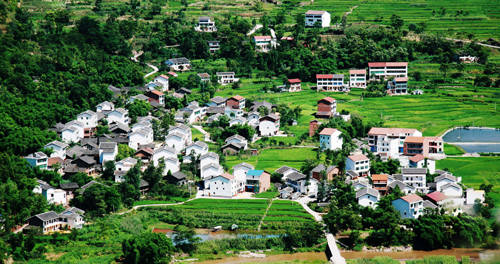|
 |
|
NEW FACE: Due to the strategy of supporting clustered poverty-stricken areas in Qinling-Bashan mountainous region, Lugang Village in Daxian County, southwest China's Sichuan Province, has taken on a new look (XINHUA) |
On March 19, the State Council's Leading Group Office of Poverty Alleviation and Development (LGOPAD), China's task force for poverty alleviation, unveiled an updated list of national-level poverty-stricken counties on its official website, with 592 counties listed as being in severe destitution. These counties will be the central locations for the country's poverty relief efforts.
Of the 592 counties, 217 are in the central region, and the rest are in the west of the country. More than 230 of these impoverished counties are located in provinces or regions inhabited by ethnic minorities.
Yunnan Province in southwest China topped the list with 73 impoverished counties. It is followed by southwest China's Guizhou Province and northwest China's Shaanxi Province, with each having 50 counties included in the list.
China started implementing its anti-poverty program in an organized and large-scale manner in 1986, designating 273 counties as national-level poverty-stricken counties.
In 1994, 592 counties in 27 provinces, municipalities and autonomous regions were listed as the key poverty-stricken counties to be aided at that time. The number of counties listed in the poverty reduction program has been capped at 592 since then.
Over the past two decades, the list has undergone three major adjustments, with more than half of the counties replaced. In 2001, the Central Government decided to exclude all counties in coastal areas from the list, leading to 33 such counties being dropped.
To be considered for the list, the counties are evaluated by factors such as the population living below the poverty line, per-capita net income and per-capita government revenue.
Zhuang Jian, a senior economist with the Asian Development Bank, said that the program has played quite a significant role in poverty alleviation in China by providing fiscal and technical support to poverty-stricken regions.
"In many listed counties, we have witnessed an improvement in the local infrastructure as well as people's access to drinking water and electricity," Zhuang said.
The update of the list of national-level poverty-stricken counties is also a response to the revision of the national poverty standard.
On November 29 last year, the Chinese Government raised the poverty threshold to 2,300-yuan ($365) annual net income of farmers, a 92-percent increase from the standard set in 2009 at 1,196 yuan ($190).
As per the new standard, an estimated 128 million rural residents were considered living in poverty at the end of 2011, accounting for 13.4 percent of the total rural population.
"The previous poverty line underestimated the number of poor people in rural China," said Wang Sangui, a professor at the School of Agricultural Economics and Rural Development of the Beijing-based Renmin University of China. "Only 2.8 percent of the rural population was officially considered poor, which was lower than many developed countries such as the United States, which has a poverty rate of about 15 percent."
Wang believes the new poverty standard better reflects the situation in China and will bring more resources to poverty-stricken regions.
The revision also means more people will be covered by the government's poverty reduction funds. According to Fan Xiaojian, head of the LGOPAD of the State Council, the country plans to allocate more money for poverty reduction this year, amounting to a 20-percent increase from the 27.2 billion yuan ($4.32 billion) allocated in 2011.
| 